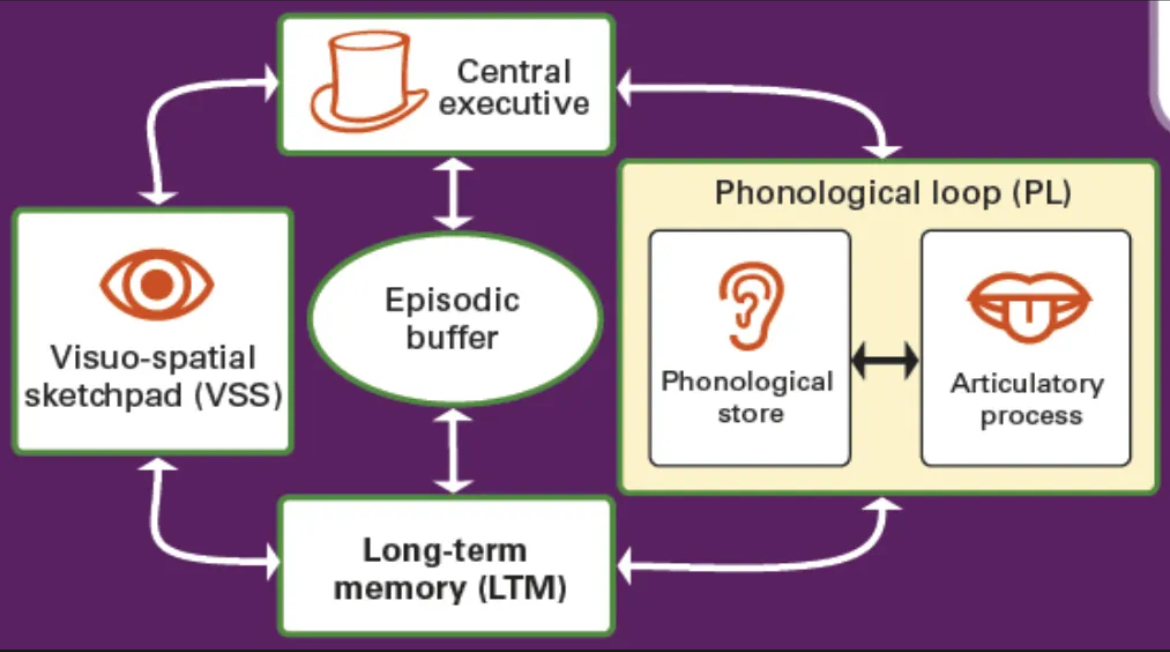The Working Memory Model
1/24
Earn XP
Description and Tags
Name | Mastery | Learn | Test | Matching | Spaced |
|---|
No study sessions yet.
25 Terms
How does the WMM differ from the MSM?
MSM was limited as it only explained stores as single units
Research shows there is multiple parts to the STM and LTM
Why did Baddeley and Hitch (1974) create the WMM?
It explains the different temporary stores of the STM
What are the four parts of the WMM?
Central executive
Phonological loop
Visio-spatial sketchpad
Episodic buffer

What is the function of the central executive?
‘Supervisor’ that monitors incoming data - focuses and divides our attention and allocates subsystems to tasks
Does the central executive have coding?
No
What is the central executive’s capacity?
Very limited as it doesn’t store information
What is the phonological loop?
Deals with auditory information and preserves the order in which information arrives
What two parts is the phonological loop split into?
Phonological store: stores the words you hear
Articulatory process: allows maintenance rehearsal, to keep items in working memory whilst they are needed
How is the phonological loop coded?
Acoustically
What is the capacity of the phonological loop?
Two seconds’ worth of words
What is the visio-spatial sketchpad?
Stores visual and spatial information
What are the two parts of the visuo-spatial sketchpad?
Visual cache: stores visual data
Inner scribe: records arrangements of objects in the visual field
Does the visuo-spatial sketchpad have coding?
No
What is the visuo-spatial sketchpad’s capacity?
3-4 objects (Baddeley 2003)
What is the episodic buffer?
Integrates visual, spatial and verbal information processed by other stores and recording events → storage for the CE
Does the episodic buffer have coding?
No
What is the episodic buffer’s capacity?
4 chunks (Baddeley 2012)
What are the strengths of the WMM?
Clinical evidence
Research support
What are the limitations of the WMM?
Evidence from clinical studies may not be reliable
Challenging evidence
Lack of clarity over the nature of the CE
Low external validity
Other explanations
What clinical evidence is there to support the WMM?
Shallice & Warrington (1970)’s case study of KF supports separate stores of STM
After a brain injury sustained from a motorcycle accident, KF had a poor STM ability for auditory information, but could process visual information normally → he could recall digits and letters when he read them, but less when they were read to him. KF’s phonological loop was damaged but his VSS was intact
What research support is there for the WMM?
Baddeley et al. (1970)’s participants carried out a dual-task, verbal and visual.
When completing the dual-task, performance was similar to when performing tasks individually.
When both tasks were visual/verbal, performance on both declined substantially → both tasks compete for the same subsystem, whereas a visual and verbal task require different parts of the STM.
Shows there must be a separate subsystem for processing visual (VSS) and verbal (PL) output.
How is the clinical evidence limited?
KF may have had other cognitive impairments other than damage to his PL → this could have affected his performance on memory tasks.
What challenging evidence is there against the WMM?
Case study of EVR: he suffered a brain tumour, which was removed from the frontal lobes of his brain.
His IQ was above average, memory was good, and scored high on reasoning tests
However, he found it impossible to make decisions → think through things logically
Demonstrates that the CE cannot be one part, as both logical decision and reasoning tests would have used the CE
Why is there lack of clarity over the nature of the CE?
Some psychologists suggest the CE contains subcomponents
The CE’s function is too vague: ‘attention’
Why does the WMM have low external validity?
Dual-task study used artificial tasks that are not representative of everyday life
Carried out in highly-controlled lab conditions
High internal validity but low external